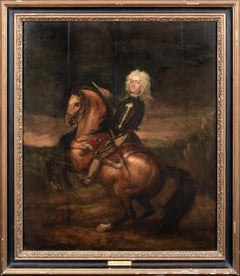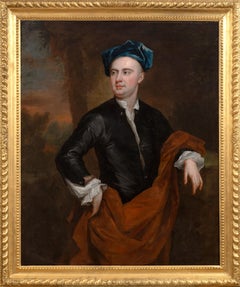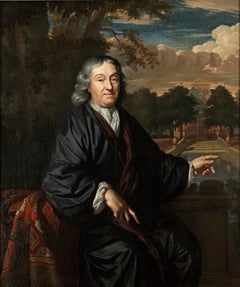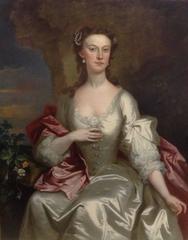John Vanderbank Art
British, 1694-1739
John Vanderbank (9 September 1694 – 23 December 1739) was an English painter who enjoyed a high reputation during the last decade of King George I's reign and remained in high fashion in the first decade of King George II's reign. George Vertue's opinion was that only intemperance and extravagance prevented Vanderbank from being the greatest portraitist of his generation, his lifestyle bringing him into repeated financial difficulties and leading to an early death at the age of only 45.
John Vanderbank first studied composition and painting under his father and then the painter Jonathan Richardson, before becoming one of Sir Godfrey Kneller's earliest pupils in 1711 at his art academy in Great Queen Street, neighbouring his father's tapestry workshop. After Sir James Thornhill took over from Kneller in 1718, Vanderbank continued his studies there for two years before founding an academy of his own in 1720.to
2
2
2
1
1
Portrait Of General John Churchill, Duke Of Marlborough The Battle Of Ramillies
By John Vanderbank
Located in Blackwater, GB
Portrait Of General John Churchill, The Duke Of Marlborough At The Battle Of Ramillies, 1706
by JOHN VANDERBANK THE YOUNGER (1694-1739)
Large early 18...
Category
18th Century John Vanderbank Art
Materials
Canvas, Oil
Portrait of an artistic Gentleman, c. 1720s
By John Vanderbank
Located in Henley-on-Thames, England
John Vanderbank (London 1694 - London 1739)
Portrait of an artistic Gentleman, c. 1720s
Three-quarter-length, wearing a turban
Oil on canvas
125.5 x 101.7 cm.; (within frame) 145.6...
Category
1720s Old Masters John Vanderbank Art
Materials
Oil
Related Items
Male and female portrait, both in silk kimono, possibly textile dealers
By Christoffel Lubieniecki
Located in Amsterdam, NL
CHRISTOFFEL LUBIENIECKI (1659-1729)
Pair of portraits of a gentleman and a lady, both in silk kimono, before a country house (circa 1680)
Indistinctly signed “C.......” on a box under the man’s left hand
Oil on canvas, 79.5 x 67 cm each
Both sitters are portrayed wearing a silk “Japanese” coat. During the second half of the seventeenth the Japanese silk coat, an adapted Japanese kimono, became a real vogue in the Dutch elite. The exclusive Dutch trade contacts with Japan can explain the popularity of the kimono-style silk coats in the Netherlands. Everybody who could afford one, dressed in such a fashionable and comfortable coat and, like the present sitters, some proud owners had themselves portrayed in a “Japanese” coat often together with an oriental carpet to underline their standing and international connections. These portraits are the work of the Polish-born portraitist Christoffel Lubieniecki (also known as Lubienitski, Lubinitski or Lubiniecki)
Lubieniecki was first trained in Hamburg under Julian Stuhr and after 1675 in Amsterdam under Adriaen Backer and Gerard de Lairesse. He specialized in landscapes, generally of an Italianate character, and in portraits. The loving execution of these contented burghers, enjoying the garden vistas of their country house, places him alongside Amsterdam portraitists such as Constantijn Netscher and Michiel van Musscher...
Category
1680s Old Masters John Vanderbank Art
Materials
Canvas, Oil
$38,214
H 31.34 in W 26.38 in D 1.97 in
Italian 18th Century Oval Religious Oil on Canvas Painting with Saint Dominic
By Francesco de Mura
Located in Firenze, IT
This beautiful Italian 18th Century old masters oil painting on oval canvas with giltwood frame is attributed to Solimena and features a religious scene.
In this splendid oval-shaped painting are depicted Saint Dominic...
Category
18th Century Old Masters John Vanderbank Art
Materials
Canvas, Oil
$13,136
H 21.66 in Dm 15.75 in
Madonna and Child with Angels in the Clouds
Located in New York, NY
Provenance: Charles H. and Virginia Baldwin, Claremont, Colorado Springs, Colorado ca. 1907-1934; thence by descent until sold in 1949 to:
Charles Blevins Davis, Claremont (renamed Trianon), Colorado Springs 1949 -until gifted in 1952 to:
The Poor Sisters of Saint Francis, Trianon, Colorado Springs, 1952 until acquired, 1960, by:
John W. Metzger, Trianon, renamed as the Trianon School of Fine Arts, Colorado Springs, 1960-1967; when transferred to:
The Metzger Family Foundation, Trianon Art Museum, Denver, 1967 - 2004; thence by descent in the Metzger Family until 2015
Exhibited: Trianon Art Museum, Denver (until 2004)
The present work is a spectacular jewel-like canvas by Amigoni, rich in delicate pastel colors, most likely a modello for an altarpiece either lost or never painted. In it the Madonna stands firmly upon a cloud in the heavens, her Child resting on a delicate veil further supported by a cloud, as he gently wraps his arm around his mother’s neck. From above angels prepare to lower flowers and a wreath, while other angels and seraphim surrounding the two joyfully cavort.
Dr. Annalisa Scarpa, author of the forthcoming monograph on Jacopo Amigoni...
Category
18th Century and Earlier John Vanderbank Art
Materials
Canvas, Oil
19th Century By Giuseppe Molteni Portrait of a Woman Oil on Canvas
Located in Milano, Lombardia
Giuseppe Molteni (Affori (Milano), Italy, 1800 - Milano, Italy, 1867)
Title: Portrait of a Woman
Medium: Oil on canvas
Dimensions: without frame 67 × 55 cm - with frame 91.5 x 80 cm
...
Category
19th Century Old Masters John Vanderbank Art
Materials
Canvas, Oil
$26,463 Sale Price
20% Off
H 26.38 in W 21.66 in D 1.97 in
17th Century by Giovanni Battista Beinaschi Saint Bartholomew Oil on Canvas
By Giovanni Battista Beinaschi
Located in Milano, Lombardia
Giovanni Battista Beinaschi (Fossano, Italy, 1636 - Naples, Italy, 1688)
Title: Saint Bartholomew
Medium: Oil on canvas
Dimensions: without frame 9...
Category
Mid-17th Century Old Masters John Vanderbank Art
Materials
Canvas, Oil
$20,353 Sale Price
22% Off
H 37.8 in W 28.15 in D 1.97 in
Early 17th Century by Tiberio Titi Portrait of a Gentleman Oil on panel
Located in Milano, Lombardia
Tiberio Titi (Florence, Italy, 1573 – 1638)
Title: Portrait of a Gentleman
Medium: Oil on panel
Dimensions: Without frame 122 x 91 cm – with frame 162 x 133 x 10 cm
Publications: G...
Category
Early 17th Century Old Masters John Vanderbank Art
Materials
Oil, Wood Panel
$84,965 Sale Price
20% Off
H 48.04 in W 35.83 in
18th Century by Alessandro Longhi Portrait of a young musician Oil on canvas
Located in Milano, Lombardia
Alessandro Longhi (Venice, Italy, 1733 – 1813)
Title: Portrait of a young musician in front of his desk with a score in his hand
Medium: Oil on canvas
Dimensions: without frame 39.5 ...
Category
18th Century Old Masters John Vanderbank Art
Materials
Canvas, Oil
$13,810 Sale Price
20% Off
H 15.56 in W 12.8 in
19th Century by Sir Henry Raeburn Portrait of a landowner Oil on canvas
By Sir Henry Raeburn
Located in Milano, Lombardia
Sir Henry Raeburn (Stockbridge, Edinburgh, UK, 1756 - Edinburgh, UK, 1823)
Title: Portrait of a landowner
Year: Early 19th century, 1803
Medium: Oil on canvas
Dimensions: Without fra...
Category
Early 19th Century Old Masters John Vanderbank Art
Materials
Canvas, Oil
$37,164 Sale Price
20% Off
H 63.78 in W 51.46 in D 1.58 in
16th Century Jan van Scorel Portrait of a member of the brotherhood of Jerusalem
By Jan van Scorel
Located in Milano, Lombardia
Jan van Scorel (Schoorl, The Netherlands, 1495 – Utrecht, The Netherlands, 1562)
Title: Portrait of a member of the brotherhood of Jerusalem
Medium: Oil on panel
Dimension: without ...
Category
16th Century Old Masters John Vanderbank Art
Materials
Oil, Wood Panel
$29,807 Sale Price
20% Off
H 24.81 in W 19.69 in
Portrait of a Lady, After Sir Peter Lely (1610-1680) Oil Painting
By After Sir Peter Lely
Located in Uppingham, GB
Oil Painting After Sir Peter Lely (1610-1680) Portrait of a Lady
Housed in a Lely gold Leaf Frame.
Peter Lely:
In 1647 he became a member of the Pain...
Category
17th Century Old Masters John Vanderbank Art
Materials
Oil
$17,060
H 57 in W 47 in D 4 in
17th Century by Andrea Vaccaro Penitent Magdalene Oil on canvas
Located in Milano, Lombardia
Andrea Vaccaro (Naples, Italy, 1604 – 1670)
Title: Penitent Magdalene
Year: 1630-1635 ca.
Medium: Oil on canvas
Dimensions: without frame 75 x 62 cm – with frame 87.5 x 74.7 x 5.5 cm...
Category
17th Century Old Masters John Vanderbank Art
Materials
Canvas, Oil
$56,293 Sale Price
20% Off
H 29.53 in W 24.41 in
Portrait of young man - The artist's son
Located in BELEYMAS, FR
Auguste-Joseph Delécluse
(Roubaix 1855 - Paris 1928)
Portrait of the artist's son, Eugène Delécluse
Oil on canvas
H. 98 cm; W. 116 cm
Signed lower right
1903
Exhibition: 1903, Salon...
Category
Early 1900s French School John Vanderbank Art
Materials
Canvas, Oil
Previously Available Items
English 18th century portrait of Elizabeth Bellenden with a spaniel
By John Vanderbank
Located in Bath, Somerset
A portrait of Elizabeth Bellenden, three-quarter length, wearing an ivory silk gown, the bodice trimmed with jewels, her hair dressed with pearls, standing on a classical terrace of a country estate (quite possibly the family owned Pontrilas family estate in Herefordshire) her outstretched hand about to pat the head of her spaniel seated beside her on a red velvet cushion on a plinth. Signed lower right 'Vanderbank Fecit'. Circa 1735. Stencil mark on the stretcher on the reverse.
Oil on canvas in a carved wood and gesso frame.
Provenance:
Christie's London, British Pictures, 24 November, 1998, lot 16
Elizabeth Bellenden was the daughter of James Bellenden, the son of John, the 2nd Lord Bellenden and so directly related to the Dukes and Earls of Roxburghe. She was married to John Jackson who was the Governor Elect of Bengal but who sadly died in 1748 before taking up his new position. They had two daughters, Mary (known as Molly) and Elizabeth. Her second husband was Edward Kelly of Dublin.
This charming composition follows in the tradition of celebrating beloved canine companions by featuring them in portraits alongside their owners. From the 17th century, the popularity of the spaniel had grown in England amongst the wealthy and upper classes and in art the pet dog was often used to symbolise the traits of loyalty and fidelity in marriage. As Elizabeth is seen here wearing white, with rings on her fingers, this may have been a portrait commissioned to celebrate her recent engagement or marriage to John Jackson.
.
John Vanderbank (1694-1739) was born in London, the eldest son of John Vanderbank Senior who was the owner of the Soho Tapestry Manufactory. He was one of the first students at Godfrey Kneller's academy, later taken over by Sir James Thornhill. In 1720 Vanderbank opened his own academy with Louis Chéron, holding life classes with both male and female models, but in 1724 fled to France to avoid debtors prison. George Vertue ( Vertue, notebooks, 3.98) noted that 'he liv'd very extravagantly, keeping a chariot horses a mistress drinking and country house a purpose for her'. In Vertue's opinion, ( Vertue, notebooks, 5.98) after Kneller's death, Vanderbank could have been the leading portrait painter of his day had he not lived so extravagantly. Vanderbank's portraits are distinguished by his rich use of colour, particularly in the flesh tones. His sitters included Sir Isaac Newton...
Category
Early 18th Century English School John Vanderbank Art
Materials
Oil
Portrait of a Lady
By John Vanderbank
Located in Bath, Somerset
Portrait of a Lady, three-quarter length, seated in a landscape wearing a white silk gown and pink cloak. Signed and dated 'Jn Vanderbank fecit 1739'. Oil on canvas in a giltwood frame.
Provenance:
Private collection, Paris until 2016.
Property of art dealer Eugene Benjamin of New Bond Street, London when sold at Christie's, London, 23rd-25th November 1898, lot 552, sold to Solomon.
John Vanderbank (1694-1739) was born in London, the eldest son of John Vanderbank Senior who was the owner of the Soho...
Category
Early 18th Century Old Masters John Vanderbank Art
John Vanderbank art for sale on 1stDibs.
Find a wide variety of authentic John Vanderbank art available for sale on 1stDibs. You can also browse by medium to find art by John Vanderbank in oil paint, paint, canvas and more. Not every interior allows for large John Vanderbank art, so small editions measuring 26 inches across are available. Customers who are interested in this artist might also find the work of John Emms, George Wright , and W. Smithson Broadhead. John Vanderbank art prices can differ depending upon medium, time period and other attributes. On 1stDibs, the price for these items starts at $12,104 and tops out at $18,616, while the average work can sell for $15,360.



